
Okonomiyaki is a typical Japanese dish, a round and flattened sweet and sour pancake, similar in appearance to an American pancake, made with cabbage, shrimp and bacon, to be garnished with a variety of toppings. The origin of this Japanese specialty is disputed between the cities of Hiroshima and Osaka, but the most popular and widespread variant is from the latter, so much so that it is also known as "Osaka pizza".
The term okonomiyaki literally means "whatever you want grilled" and, according to tradition, the dish should be cooked on the teppan, a hot plate often placed directly on the diners' table. The recipe is quite famous because, like many in Japanese culture, it has been represented several times in anime and manga. Nowadays, you can find okonomiyaki in many Asian restaurants in the main American cities.
Preparing them at home, with the original Osaka recipe, is easy: you will have to brown the bacon in a non-stick pan for a few minutes and, in the meantime, cut the cabbage into julienne strips and prepare a simple batter made from flour, water and egg, into which you will pour the cabbage and the previously cleaned prawns. You will then just have to mix everything and pour it into the pan with the crispy bacon, cooking for a few minutes, until the mixture has solidified.
You can serve your okonomiyaki garnished with different sauces and ingredients: in our version we prepared the classic okonomiyaki sauce with ketchup, Worcestershire sauce and soy sauce, garnishing with mayonnaise, katsuobushi, chopped nori seaweed sheets and fresh ginger, but you can also opt for tenkasu, which are fried tempura batter flakes, spring onion and beni shoga, a type of pickled red ginger.
Born as street food, okonomiyaki can be served as an appetizer during an oriental-themed dinner with friends, combined with other Japanese dishes.
What is Okonomiyaki?
Okonomiyaki, often referred to as a "Japanese savory pancake," has deep roots in Japan’s culinary history, with its origins tracing back to the 16th century. The dish was initially influenced by the Western concept of pancakes, but over time, it evolved into a distinct Japanese creation. Its name, "okonomi," translates to "what you like" or "how you like," and "yaki" means "grilled" or "cooked," reflecting the dish’s customizable nature. Early versions of okonomiyaki were influenced by a dish called "funoyaki," a simple flour-based batter used as a substitute for rice during times of scarcity.
During the post-World War II era, particularly in Osaka, okonomiyaki began to take the shape of the dish we recognize today. In the face of food shortages, locals started adding more ingredients to the batter, including cabbage, pork, and seafood, making it a hearty and affordable meal. This innovation led to the birth of two major regional styles: the Kansai (Osaka) style, where ingredients are mixed into the batter, and the Hiroshima style, where they are layered. Today, okonomiyaki is a beloved comfort food in Japan and has gained international popularity.
What Does Okonomiyaki Taste Like?
Okonomiyaki has a savory, slightly sweet flavor with a rich umami depth. The batter, made from flour and eggs, provides a soft and slightly chewy texture, while the cabbage adds a crunch. The toppings, which can include pork, seafood, or even cheese, bring additional flavors and textures. The dish is often finished with a tangy okonomiyaki sauce (similar to Worcestershire sauce), a dollop of creamy mayonnaise, and sometimes bonito flakes, which infuse the pancake with a smoky, savory taste.
Pro Tips for The Best Okonomiyaki
- Fresh cabbage is key to getting that perfect balance of texture. Make sure to chop it finely, as smaller pieces mix better with the batter, ensuring an even cook and preventing sogginess.
- The batter for okonomiyaki should be just mixed until combined. Overmixing will make it dense and heavy instead of light and fluffy. You want the batter to be a bit lumpy to keep the pancake airy.
- Make sure your griddle or pan is hot enough before adding the batter. A medium-high heat works best to create a crispy golden-brown crust while keeping the inside tender. Avoid overcrowding the pan to allow proper cooking.
- If you're adding proteins like pork, shrimp, or squid, place them on top of the pancake batter as soon as you pour it onto the griddle. This ensures they cook evenly and are well incorporated into the pancake.
- Flipping okonomiyaki can be tricky. Use a wide spatula and gently flip it in one motion to prevent it from breaking apart. You can use a second spatula to support the flip if needed.
- The okonomiyaki sauce can be sweet, tangy, or even spicy, depending on your preference. Don’t be afraid to adjust the amount or add extra ingredients like bonito flakes, pickled ginger, or seaweed to elevate the flavor.
- Once cooked, allow the okonomiyaki to rest for a minute or two. This lets the flavors settle and makes it easier to slice and serve.
What is The Moving Stuff on Okonomiyaki?
The moving stuff on okonomiyaki is likely bonito flakes (katsuobushi), which are thin, dried fish flakes that gently "dance" when placed on the hot pancake due to the heat. It creates a cool visual effect and adds a smoky, umami flavor to the dish.
What Are The Two Styles of Okonomiyaki?
The two main styles of okonomiyaki are:
- Kansai (Osaka) Style: In this style, all ingredients are mixed directly into the batter before cooking, creating a more uniform pancake.
- Hiroshima Style: Here, the ingredients are layered rather than mixed. The batter is cooked first, followed by toppings like cabbage, pork, and noodles, which are layered on top and cooked together.
Filling Ideas for Okonomiyaki
You can start with the classic cabbage base, but feel free to get creative with the additions. Popular fillings include thinly sliced pork belly, shrimp, squid, or even thin cuts of beef. For a more vegetarian option, you might use mushrooms, tofu, or even sweet potato. Some people love adding grated cheese or even kimchi for a unique twist. You can also incorporate cooked noodles, such as yakisoba, for a hearty version.
Can I Make Vegan Okonomiyaki?
The vegan version of okonomiyaki involves preparing a batter with 100 grams of 0 flour, 150 grams of wholemeal flour, a teaspoon of baking powder, a pinch of salt and ginger, to which water or soy milk will be added until the mixture is creamy and smooth. At that point, in addition to the cabbage, vegetables, seaweed and greens can be added, to be mixed into the mixture and fried in a non-stick pan or on the teppan. To garnish, just a spoonful of vegetable mayonnaise and a little vegan okonomiyaki sauce will be enough, made with a teaspoon of corn starch, half a glass of cold water, four tablespoons of tomato paste, a tablespoon of soy sauce and half of powdered ginger.
Can I Make It Ahead of Time?
While it's best to enjoy okonomiyaki fresh off the griddle for optimal texture and flavor, you can prepare some parts of the dish ahead of time. You can chop the vegetables, prepare the batter, and even cook the proteins in advance. When you're ready to serve, simply assemble and cook the okonomiyaki on the griddle.
Does It Freeze Well?
Okonomiyaki doesn’t freeze particularly well due to its delicate texture. Freezing can cause the batter and fillings to become soggy when reheated. If you must freeze it, it’s best to freeze the cooked okonomiyaki before adding toppings like sauce and mayo. When reheating, it’s better to use a stovetop or griddle to bring back some crispiness, but the texture might still be affected.
How to Store Any Leftovers
To store leftovers, place the cooked okonomiyaki in an airtight container and refrigerate them for up to one day. For the best results, separate the sauce and toppings (like mayo and bonito flakes) and store them separately. When you're ready to enjoy, reheat the okonomiyaki on a skillet or griddle to regain some of the crispy texture. Avoid microwaving, as it may make the pancakes soggy.
Ingredients
How to Make Okonomiyaki
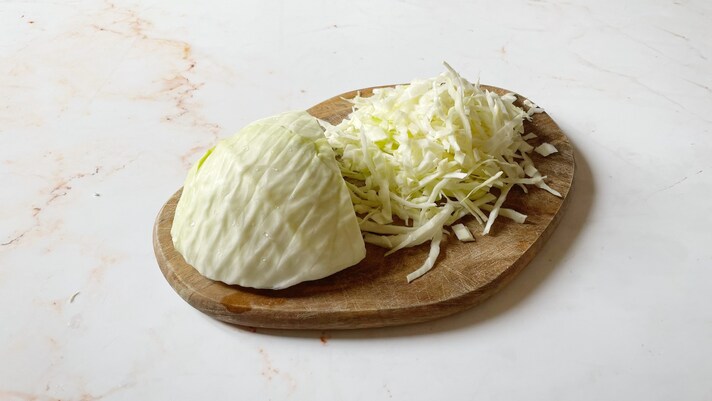
Wash the cabbage and cut it into julienne strips.
Wash the cabbage and cut it into julienne strips.

Pour a drizzle of oil into a non-stick pan, add the bacon and brown for 2 minutes.
Pour a drizzle of oil into a non-stick pan, add the bacon and brown for 2 minutes.
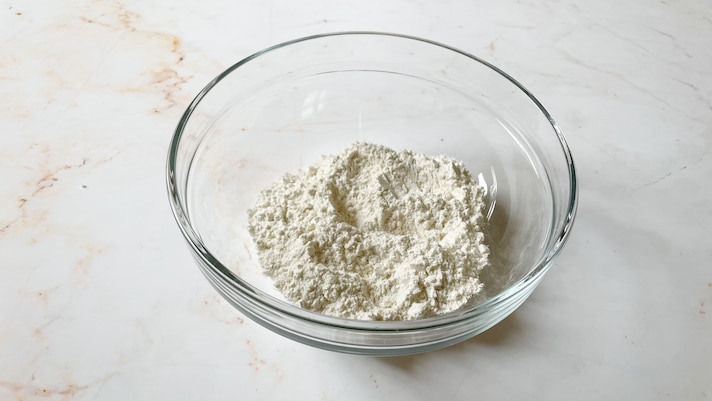
Prepare the batter by combining the flour in a large bowl.
Prepare the batter by combining the flour in a large bowl.

Pour the water.
Pour the water.
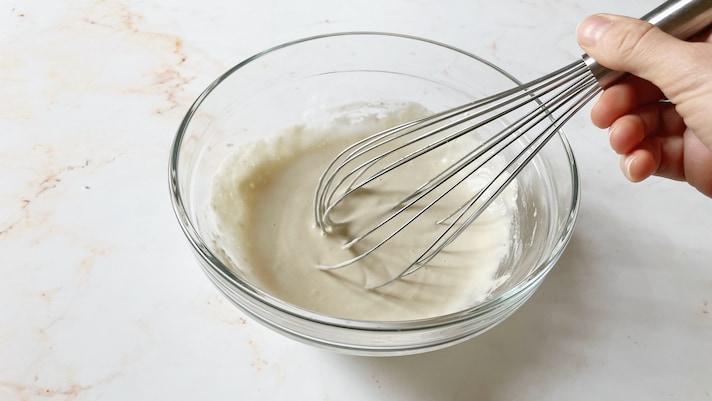
Mix well with a whisk until you get a smooth mixture.
Mix well with a whisk until you get a smooth mixture.
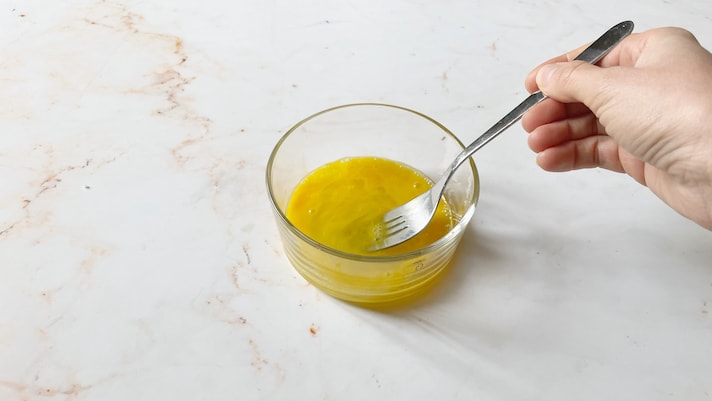
Separately, beat the eggs with a fork.
Separately, beat the eggs with a fork.
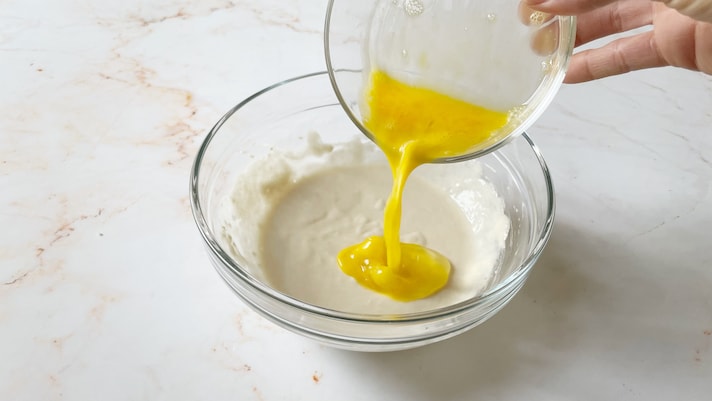
Add the eggs to the flour and water batter.
Add the eggs to the flour and water batter.

Mix well with a whisk.
Mix well with a whisk.
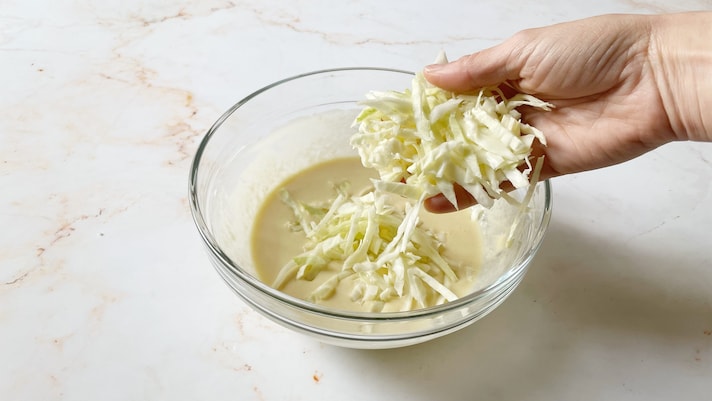
Add the cabbage.
Add the cabbage.
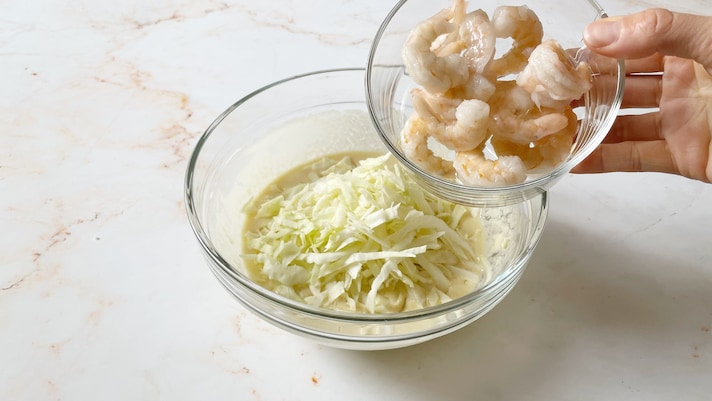
Also add the whole shrimp, previously cleaned.
Also add the whole shrimp, previously cleaned.

Mix all the ingredients well.
Mix all the ingredients well.
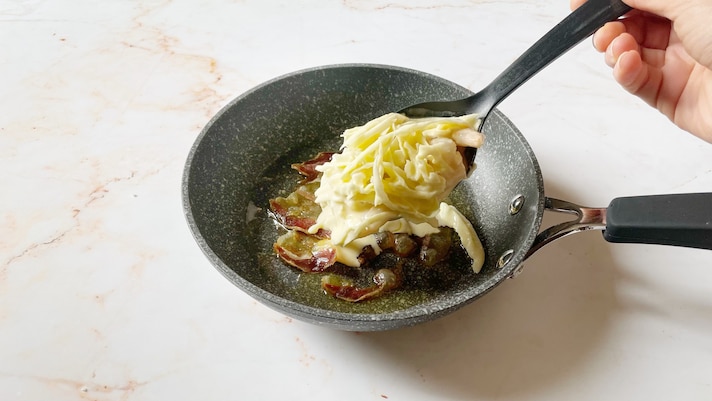
Pour a ladle of batter into the pan with the crispy bacon.
Pour a ladle of batter into the pan with the crispy bacon.
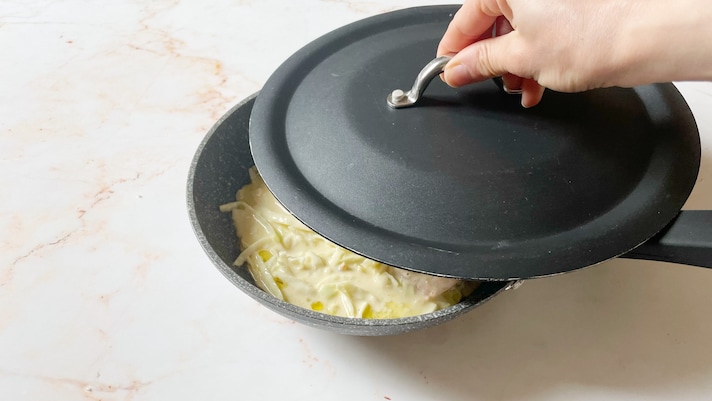
Cover with a lid and cook for 7 minutes on low heat.
Cover with a lid and cook for 7 minutes on low heat.
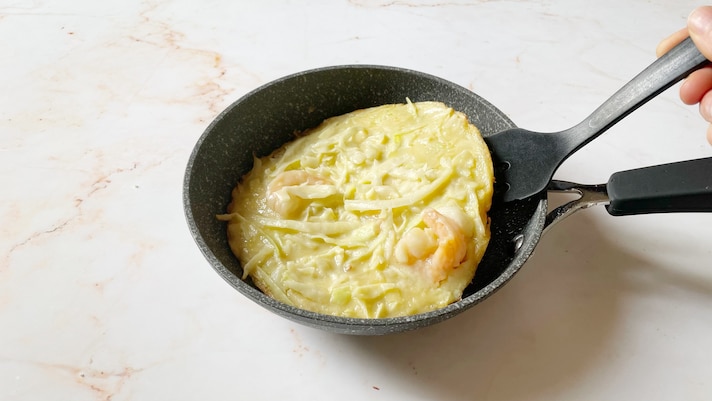
Turn the okonomiyaki over with the help of a spatula.
Turn the okonomiyaki over with the help of a spatula.
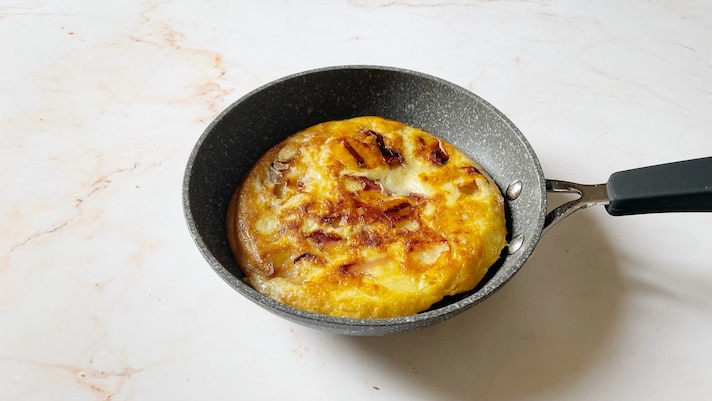
Continue cooking for another 4 minutes, always with the lid.
Continue cooking for another 4 minutes, always with the lid.
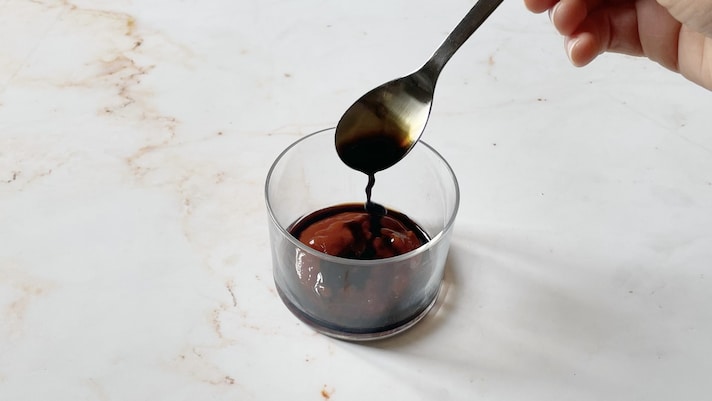
In the meantime, prepare the okonomiyaki sauce: in a small bowl, pour the ketchup, the Worcestershire sauce and the soy sauce.
In the meantime, prepare the okonomiyaki sauce: in a small bowl, pour the ketchup, the Worcestershire sauce and the soy sauce.
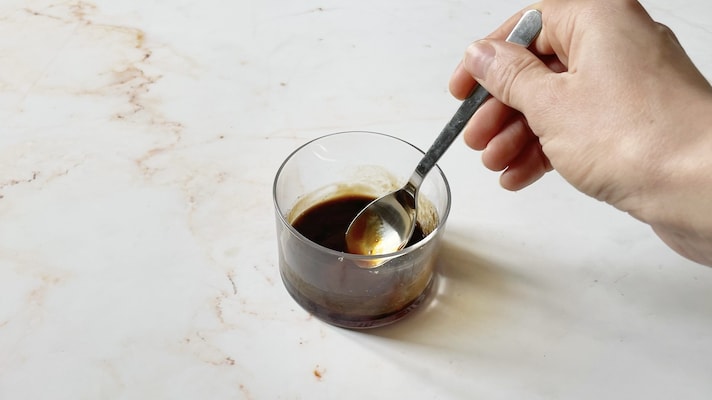
Mix well to blend the ingredients.
Mix well to blend the ingredients.
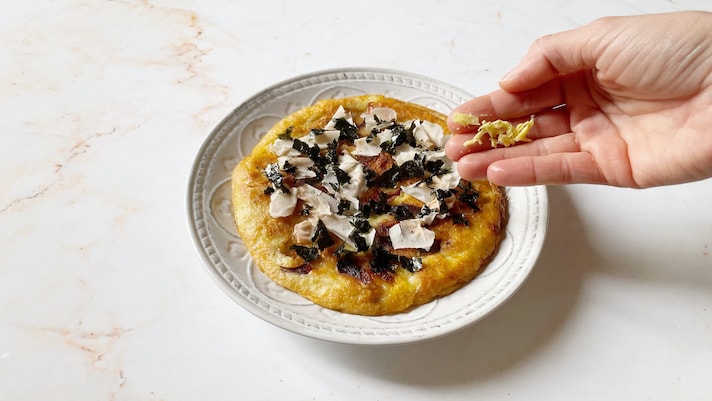
Once cooked, transfer the okinomiyaki to a serving plate and garnish with the katsuobushi, chopped nori seaweed and ginger.
Once cooked, transfer the okinomiyaki to a serving plate and garnish with the katsuobushi, chopped nori seaweed and ginger.
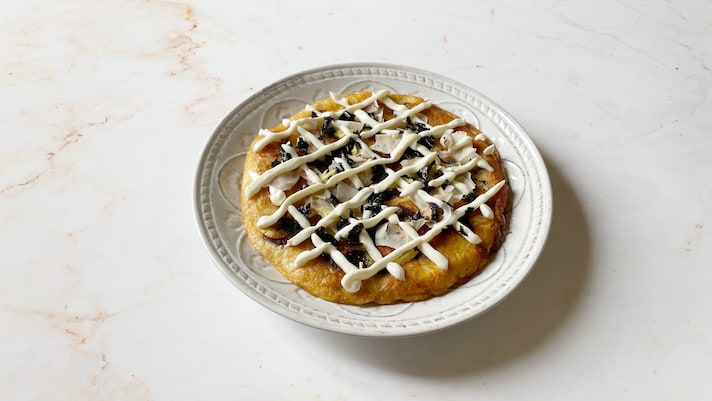
Spread the mayonnaise, forming a lattice.
Spread the mayonnaise, forming a lattice.

Add the okonomiyaki sauce and serve immediately. Enjoy!
Add the okonomiyaki sauce and serve immediately. Enjoy!
;Resize,width=767;)
